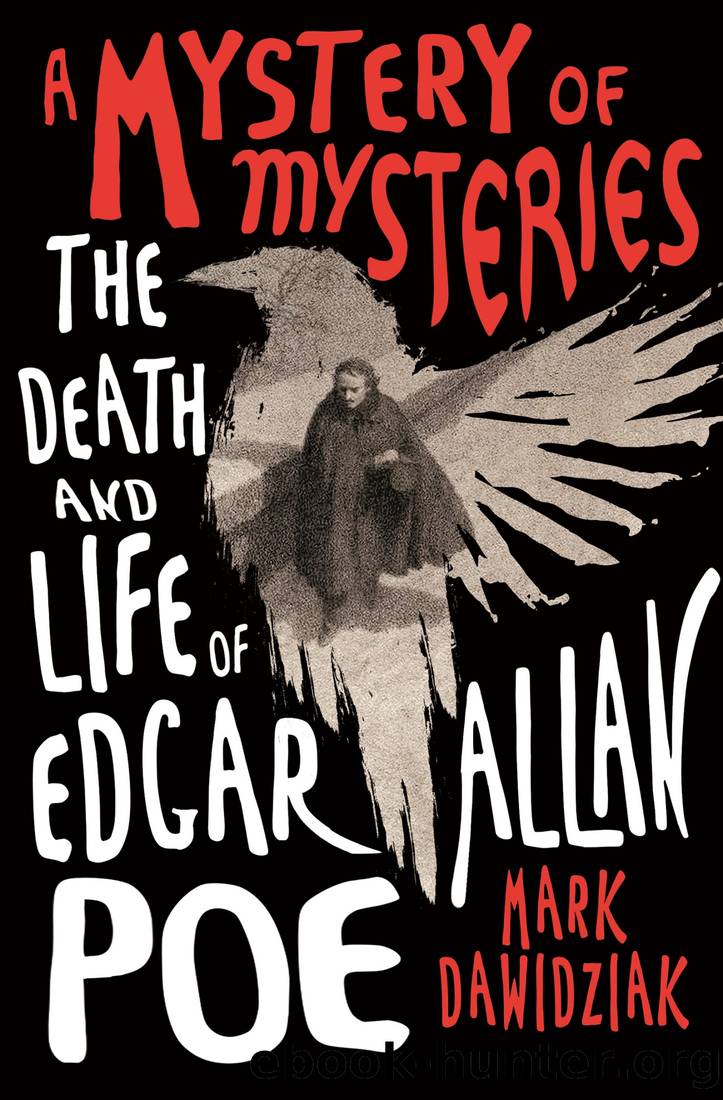A Mystery of Mysteries: The Death and Life of Edgar Allan Poe by Mark Dawidziak

Author:Mark Dawidziak [Dawidziak, Mark]
Language: eng
Format: epub
Publisher: St. Martin's Publishing Group
Published: 0101-01-01T00:00:00+00:00
âRATHER THE WORSE FOR WEARâ
SEPTEMBER 27âOCTOBER 3, 1849
The days after Poe left Richmond on September 27, 1849, are completely shielded from our view. We have no reliable testimony establishing his whereabouts until the afternoon of Wednesday, October 3. If, indeed, he left Richmond on a steam packet, as it is generally assumed, he would have arrived in Baltimore on September 28. No one who made the trip with him came forward to describe his physical condition and emotional state on board. Not one person stepped forward after Poeâs death to recall a conversation or brief encounter at the steamerâs railing. Did he fall to drinking, reaching Baltimore in a dangerously weakened and inebriated state? The steamers had saloons by then, so alcohol would have been available during the trip.
âEven a very small amount of alcohol had a terrible impact on him, but thereâs no evidence that he was drinking at that point,â Edgar Allan Poe Society of Baltimore secretary and treasurer Jeffrey A. Savoye said. âAnd itâs somewhat simplistic to jump to, well, he started drinking on the boat and he drank himself to death.â
He would have disembarked at Spearâs Wharf in Baltimore. Did he then walk about eight blocks or so to the station at President Street and catch a train to Philadelphia? He had planned to go there and edit the poems of Mrs. Marguerite St. Leon Loud. If he did make the trip, he didnât make contact with the Louds, nor did he make any attempt to collect a badly needed one hundred dollars for his editorial assistance. Was he sick and feverish, as Elmira Royster Shelton had seen him the night before his departure? Was he already dying when he left Richmond? Or was Dr. Gibbon Carterâs dire warning a couple of months earlier all too accurate and another bout of drinking did prove fatal? Itâs not that thereâs too little evidence to support conjecture. Itâs that thereâs almost no evidence. Or as Poe scholar Steve Medeiros summarizes it, âThe only thing weâre certain of is our uncertainty.â
Any eastern city with a seaport area would have had its rowdy and dangerous areas. Even allowing for that, Baltimore had picked up a particularly rough reputation in the 1830s and â40s. It also had picked up a nicknameâMobtown.
âThey would riot at the drop of a hat,â said Baltimore Poe scholar Jeff Jerome, and indeed, in addition to the 1835 riot, Baltimore erupted into violence in 1777, 1812, 1839, 1856, 1861, and 1877. âWe took our riots very seriously back then, making the police hide, chasing the mayor out of town, burning down houses.â
Heâs not exaggerating. Right before Poe left the Amity Street house for Richmond in 1835, the August 6â9 Baltimore bank riot claimed the homes of some of the cityâs most prominent citizens. The unrest was sparked by the failure of the Bank of Maryland, which resulted in the loss of savings for thousands of depositors. Whipped into a fighting mood after months of accusations of fraud
Download
This site does not store any files on its server. We only index and link to content provided by other sites. Please contact the content providers to delete copyright contents if any and email us, we'll remove relevant links or contents immediately.
Kathy Andrews Collection by Kathy Andrews(10543)
The remains of the day by Kazuo Ishiguro(7570)
Spare by Prince Harry The Duke of Sussex(4216)
Paper Towns by Green John(4175)
The Body: A Guide for Occupants by Bill Bryson(3813)
Be in a Treehouse by Pete Nelson(3230)
Harry Potter and the Goblet Of Fire by J.K. Rowling(3062)
Goodbye Paradise(2972)
Never by Ken Follett(2901)
Into Thin Air by Jon Krakauer(2710)
The Remains of the Day by Kazuo Ishiguro(2626)
The Genius of Japanese Carpentry by Azby Brown(2613)
The Cellar by Natasha Preston(2602)
Drawing Shortcuts: Developing Quick Drawing Skills Using Today's Technology by Leggitt Jim(2534)
120 Days of Sodom by Marquis de Sade(2444)
Architecture 101 by Nicole Bridge(2355)
Machine Learning at Scale with H2O by Gregory Keys | David Whiting(2305)
The Man Who Died Twice by Richard Osman(2303)
Industrial Automation from Scratch: A hands-on guide to using sensors, actuators, PLCs, HMIs, and SCADA to automate industrial processes by Olushola Akande(2103)
